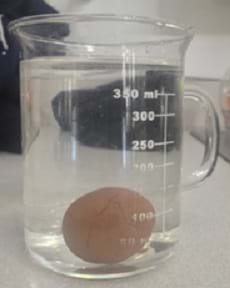Quick Look
Grade Level: Middle school
Time Required: 1 hour
Expendable Cost: US $0.75
Group Size: 2
Subject Areas: Measurement, Physical Science
Introduction
Bolded words are vocabulary and concepts to highlight with students during the activity.
What is density? Density is equal to the mass of an object per unit volume. For example, a brick is heavier than a Styrofoam block of the same size (volume); this means the brick is denser than the Styrofoam. If an object is less dense than a liquid, the object will float in the liquid. If an object is denser than a liquid, then the object will sink in the liquid. 
If we put a ball of clay in water, it sinks; clay is denser than water. So, how can we make a boat out of clay that floats? We must make the clay buoyant by forming it into a shape that helps it float on top of the water. This only works if we can make the clay into a shape that displaces a mass of water equal to or greater than the mass of the clay itself. Why is this important? Buoyancy is what makes things float, and understanding this principle helps us design things that work, such as ships, hot air balloons and life-vests.
Supplies
Each group needs:
- 2 oz. (60 g) clay
- 12" (30 cm) masking tape
- 1 sheet wax paper
- 4-5 paper towels
- tub of water (shared)
- washers, pennies, etc. (shared, used as weight)
Subscribe
Get the inside scoop on all things TeachEngineering such as new site features, curriculum updates, video releases, and more by signing up for our newsletter!Procedure
Instruct students to work in teams of two. First, they design their boats, keeping in mind that the boats must float while holding weight and that they have a limited amount of clay to use. Students can test their designs and make changes as often as they like. The goal is to create boats that can hold as much weight as possible while staying afloat.
Building and Testing Boats
Note: Be sure students dry the clay with a paper towel after taking it out of the water and between trials, otherwise it will become too wet to manipulate.
- Instruct students to tape a piece of wax paper to their desks to serve as their "work stations."
- Hold a brainstorming session with students about ways to make a ball of clay into a floating object. Ask them what shapes they think will work best and have them make predictions about how many weights their boats will hold.
- Instruct students to spend a few minutes constructing a floating object with their clay. One group at a time, place it in the tub of water to see if it floats.
- If it floats, help students add weights, one at a time, until it sinks. On the classroom board, track how many weights each group's boat held before failure, for each trial.
- Encourage students to try a variety of designs to determine which works the best.
- After testing, have each team share its best boat design and how much weight it held. Have students discuss common themes between the successful designs and how the designs compare to real-world, full-size boats and rafts.
Wrap Up - Thought Questions
- Which designs worked the best? Why?
- Which designs did not work well? Why not?
- Why does a piece of steel sink in water while a steel boat floats?
More Curriculum Like This

Students use modeling clay, a material that is denser than water and thus ordinarily sinks in water, to discover the principle of buoyancy. They begin by designing and building boats out of clay that will float in water, and then refine their designs so that their boats will carry as great a load (m...

Students learn that buoyancy is responsible for making boats, hot air balloons and weather balloons float. They calculate whether or not a boat or balloon will float, and calculate the volume needed to make a balloon or boat of a certain mass float.

Students are introduced to the important concept of density with a focus is on the more easily understood densities of solids. Students use different methods to determine the densities of solid objects, including water displacement to determine volumes of irregularly-shaped objects. By comparing den...

Students conduct a simple experiment to see how the water level changes in a beaker when a lump of clay sinks in the water and when the same lump of clay is shaped into a bowl that floats in the water.
Copyright
© 2013 by Regents of the University of ColoradoLast modified: May 12, 2022










User Comments & Tips